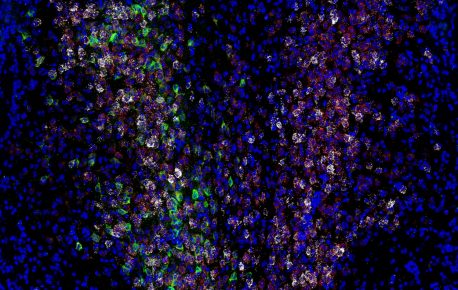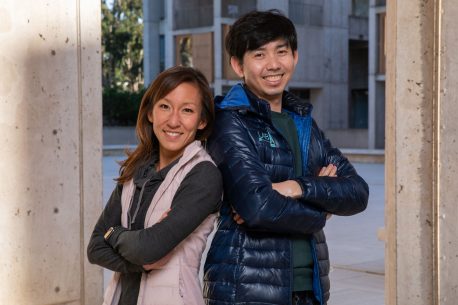
July 20, 2022
Salk researchers pinpoint a neurotransmitter that helps assign positive or negative emotions to a memory
Salk researchers pinpoint a neurotransmitter that helps assign positive or negative emotions to a memory
LA JOLLA—Researchers at the Salk Institute and colleagues have discovered the molecule in the brain responsible for associating good or bad feelings with a memory. Their discovery, published in Nature on July 20, 2022, paves the way for a better understanding of why some people are more likely to retain negative emotions than positive ones—as can occur with anxiety, depression or post-traumatic stress disorder (PTSD).
“We’ve basically gotten a handle on the fundamental biological process of how you can remember if something is good or bad,” says senior author Kay Tye, a professor in Salk’s Systems Neurobiology Laboratory and a Howard Hughes Medical Institute Investigator. “This is something that’s core to our experience of life, and the notion that it can boil down to a single molecule is incredibly exciting.”
For a human or animal to learn whether to avoid, or seek out, a particular experience again in the future, their brain must associate a positive or negative feeling, or “valence” with that stimulus. The brain’s ability to link these feelings with a memory is called “valence assignment.”
In 2016, Tye discovered that a group of neurons in the brain’s basolateral amygdala (BLA) helps assign valence when mice are learning. One set of BLA neurons was activated with positive valence, as the animals learned to associate a tone with a sweet taste. A separate set of BLA neurons was activated with negative valence, as the animals learned to associate a different tone with a bitter taste.

“We found these two pathways—analogous to railroad tracks—that were leading to positive and negative valence, but we still didn’t know what signal was acting as the switch operator to direct which track should be used at any given time,” says Tye, holder of the Wylie Vale Chair.
In the new study, the researchers homed in on the importance of the signaling molecule neurotensin to these BLA neurons. They already knew that neurotensin is a neuropeptide produced by the cells associated with valence processing, but so are a few other neurotransmitters. So they used CRISPR gene editing approaches to selectively remove the gene for neurotensin from the cells—the first time that CRISPR has been used to isolate specific neurotransmitter function.
Without neurotensin signaling in the BLA, mice could no longer assign positive valence and didn’t learn to associate the first tone with a positive stimulus. Interestingly, the absence of neurotensin did not block negative valence. The animals instead became even better at negative valence, having a stronger association between the second tone and a negative stimulus.
The findings suggest that the brain’s default state is to have a bias toward fear—the neurons associated with negative valence are activated until neurotensin is released, switching on the neurons associated with positive valence. From an evolutionary perspective, Tye says, this makes sense because it helps people avoid potentially dangerous situations—and it probably resonates with people who tend to find the worst in a situation.
In further experiments, Tye and her team showed that high levels of neurotensin promoted reward learning and dampened negative valence, further supporting the idea that neurotensin is responsible for positive valence.

“We can actually manipulate this switch to turn on positive or negative learning,” says co-first author Hao Li, a postdoctoral fellow in the Tye Lab. “Ultimately, we’d like to try to identify novel therapeutic targets for this pathway.”
The researchers still have questions about whether levels of neurotensin can be modulated in people’s brains to treat anxiety or PTSD. They are also planning future studies to probe what other brain pathways and molecules are responsible for triggering the release of neurotensin.
Other authors of the paper were Matilde Borio, Mackenzie Lemieux, Austin Coley, Avraham Libster, Aneesh Bal, Caroline Jia, Jasmin Revanna, Kanha Batra, Kyle Fischer, Laurel Keyes, Nancy Padilla-Coreano and Romy Wichmann of Salk; Praneeth Namburi, Jacob Olson, Anna Beyeler, Gwendolyn Calhoon, Natsuko Hitora-Imamura, Ada Felix-Ortiz, Verónica de la Fuente, Vanessa Barth, Hunter King, Ehsan Izadmehr, Cody Siciliano and Ila Fiete of MIT; Xin Jin, Sourav Choudhury, Xi Shi and Feng Zhang of the Broad Institute of MIT and Harvard; Huan Wang and Yulong Li of Peking University; and Kenneth McCullough and Kerry Ressler of Harvard Medical School.
The work was supported by the JPB Foundation, PIIF, PNDRF, JFDP, Alfred P. Sloan Foundation, New York Stem Cell Foundation, Klingenstein Foundation, McKnight Foundation, Clayton Foundation, National Institutes of Health (R01-MH102441, RF1-AG047661, DP2-DK102256, DP1-AT009925, F32 MH115446-01 and K99 DA055111), the Brain and Behavior Research Foundation, MEXT (15K21744, 17H06043), the Uehara Memorial Foundation, Singleton, Leventhal and Whitaker fellowships, a fellowship from the Swiss National Science Foundation and a Fulbright scholarship.
DOI: 10.1038/s41586-022-04964-y
JOURNAL
Nature
AUTHORS
Hao Li, Praneeth Namburi, Jacob M. Olson, Matilde Borio, Mackenzie E. Lemieux, Anna Beyeler, Gwendolyn G. Calhoon, Natsuko Hitora-Imamura, Austin A. Coley, Avraham Libster, Aneesh Bal, Xin Jin, Huan Wang, Caroline Jia, Sourav R. Choudhury, Xi Shi, Ada C. Felix-Ortiz, Verónica de la Fuente, Vanessa P. Barth, Hunter O. King, Ehsan M. Izadmehr, Jasmin S. Revanna, Kanha Batra, Kyle B. Fischer, Laurel R. Keyes, Nancy Padilla-Coreano, Cody A. Siciliano, Kenneth M. McCullough, Romy Wichmann, Kerry J. Ressler, Ila R. Fiete, Feng Zhang, Yulong Li and Kay M. Tye
Office of Communications
Tel: (858) 453-4100
press@salk.edu
Unlocking the secrets of life itself is the driving force behind the Salk Institute. Our team of world-class, award-winning scientists pushes the boundaries of knowledge in areas such as neuroscience, cancer research, aging, immunobiology, plant biology, computational biology and more. Founded by Jonas Salk, developer of the first safe and effective polio vaccine, the Institute is an independent, nonprofit research organization and architectural landmark: small by choice, intimate by nature, and fearless in the face of any challenge.